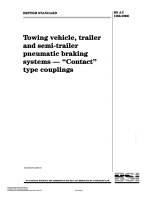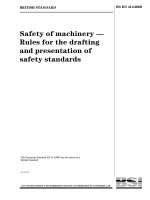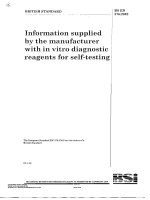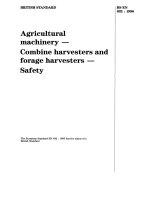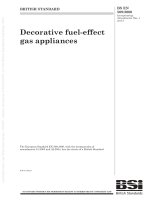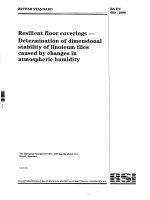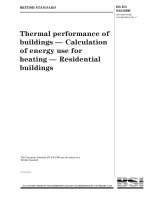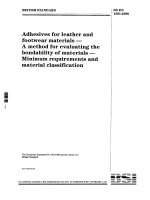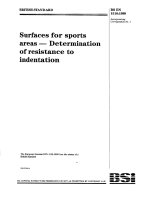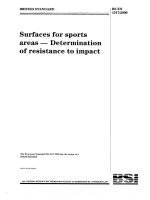Bsi bs en 01551 2000 scan
Bạn đang xem bản rút gọn của tài liệu. Xem và tải ngay bản đầy đủ của tài liệu tại đây (3.13 MB, 75 trang )
STDmBSI BS EN L55L-ENGL 2000 II Lb24bb9 0862289 ab9
BRITISH STANDARD
35 EN
1551:ZOOO
The European Standard EN 1551:2ûûûhas the status of a
British Standard
ICs 53.060
NO COPYING WITHOUT BSI PERMISSION EXCEPT AS PERMiïTED BY COPYBIGHT LAW
Copyright European Committee for Standardization
Provided by IHS under license with CEN
No reproduction or networking permitted without license from IHS
Not for Resale
--````,`-`-`,,`,,`,`,,`---
Safety of industrial
trucks - Self propelled
trucksoverlO000kg
capacity
STDoBSI BS EN 155L-ENGL 2000
L b 2 4 6 6 7 O B b 2 2 7 0 580 W
BS EN 1551:2000
National foreword
This British Standard is the official English language version of EN 1551:2000.
The UK participation in its prepasation was entrusted to Technical Committee
M H E l i , Industrial tnicks - Safety, which has the responsibility to:
- aid enquirers to understand the text,
- present to the responsible European committee any enquiries on the
interpretation, or proposals for change, and keep the UK interests informed;
- monitor related international and European developments and promulgate
them in the UK.
A list of organizations represented on this committee can be obtained on request to
its secretary.
Cross-references
The British Standards which implement international or European publications
referred to in this document may be found in the BSI Standards Catalogue under the
section entitled “International Standards Correspondence Index”, or by using the
“Find” facility of the BSI Standards Electronic Catalogue.
--````,`-`-`,,`,,`,`,,`---
A British Standard does not purport to include alI the necessary provisions of a
contract. Users of British Standards are responsible for their correct application.
Compliance with a British Standard does not of itself confer immunity
from legal obligations.
Summary of pages
This document comprises a front cover, an inside front cover, the EN title page,
pages 2 to 72, an inside back cover and a back cover.
The BSI copyright notice displayed in this document indicates when the document
was last issued
been prepared under the
direction of the Engineering
Sector Committee, was published
under the authority of the
Standards Committee and comes
into effect on 15 July 2000
Amd. No.
Date
Comments
O BSI 07-2000
ISBN O 580 35352 4
Copyright European Committee for Standardization
Provided by IHS under license with CEN
No reproduction or networking permitted without license from IHS
Not for Resale
~
~
STD-BSI BS EN 1551-ENGL 2000
L b 2 4 b b î Oäb2291 Y17
EN 1551
EUROPEAN STANDARD
NORME EUROPEENNE
EUROPAISCHE NORM
April 2000
ICs 53.060
English version
Safety of industrial trucks - Self propelled trucks over 10 O00 kg
capacity
Sicherheit von Flurfưrderzeugen- Krtbetriebene
Flurfưrderzeugber 10 O00 kg Tragfähigkeit
Sbcurité des chariots de manutention - Chariots
automoteurs de plus de 10 O00 kg
This European Standard was approved by CEN on 16 April 1999.
CEN members are bound to comply with the CENICENELEC Intemal Regulationswhich stipulate the conditions for giving this European
Standard the status of a national standard without any alteration. Up-to-date lists and bibliographical references concerning sich national
standards may be obtained on application to the Central Secretariat or to any CEN member.
This European Standard exists in three official versions (English, French, German). A version in any other language made by traislation
under the responsibilityof a CEN member into its own language and notified to the Central Secretariat has the same status as tie official
versions.
--````,`-`-`,,`,,`,`,,`---
CEN members are the national standards bodies of Austria, Belgium, Czech Republic, Denmark, Finland, France, Germany, Greece,
Iceland, Ireland, Italy, Luxembourg, Netherlands, Norway, Portugal, Spain, Sweden, Switzerland and United Kingdom.
EUROPEAN COMMIïTEE FOR STANDARDIZATION
C O M I T É EUROPÉEN D E N O R M A L I S A T I O N
EUROPÄISCHES KOMITEE FÜR NORMUNG
Central Secretariat: rue de Stassart, 36
O 2000 CEN
All rights of exploitation in any form and by any means reserved
worldwide for CEN national Members.
Copyright European Committee for Standardization
Provided by IHS under license with CEN
No reproduction or networking permitted without license from IHS
Not for Resale
8-1050 Brussels
Ref. No. EN 1551:2000 E
Page 2
EN 1551:2000
Contents
Foreword
3
Introduction
5
1
Scope
5
2
Normative references
6
3
Definitions
7
4
List of hazards
IO
5
Requirements
18
6
Verification of safety requirements andlor measures
30
7
Information for use
32
Annex A (normative) Single side loading fork lift trucks
-Stability tests
37
43
Annex C (normative) Bi-directional and multi-directionaltrucks -Stability tests
48
Annex D (normative) Trucks operated with offset load (offset determined by utilization)
additional stability test
57
Annex E (normative) Side loading trucks handling freight containers of 6 m length and above
additional stability tests
61
Annex F (normative) Overhead guard - Impact drop test
67
Annex G (informative) Loading control
69
Annex ZA (informative) Clauses of this European Standard addressing essential requirements
or other provisions of EU directives
72
--````,`-`-`,,`,,`,`,,`---
Annex B (normative) Rough terrain trucks with masts - Stability tests
Q BSI 07-2000
Copyright European Committee for Standardization
Provided by IHS under license with CEN
No reproduction or networking permitted without license from IHS
Not for Resale
~
STDBBSI BS EN L551-ENGL 2 0 0 0
1624669 08b2293 29T
Page 3
EN 1551:2000
Foreword
This European Standard has been prepared by Technical Committee CEN/TC 150, Industrial Trucks
Safety, the Secretariat of which is held by BSI.
-
--````,`-`-`,,`,,`,`,,`---
This European Standard shall be given the status of a national standard, either by publication of an identical
text or by endorsement, at the latest by October 2000 conflicting national standards shall be withdrawn at the
latest by October 2000.
This European Standard has been prepared under a mandate given to CEN by the European Commission
and the European Free Trade Association, and supports essential requirements of EU Directive(s).
For relationship with EU Directive(s), see informative Annex ZA,which is an integral part of this standard.
This European Standard is one of a series of European Standards for the safety of Industrial trucks. The
complete series is as follows:
EN 1726,
Safety of Industrial trucks - Self propelled trucks up to and including 1O O00 kg capacity
and industrial tractors with a drawbar pull up to and including 20 O00 N
EN 1726-1,
Part 1 :General requirements
EN 1726-2,
Part 2 :Additional requirements for trucks with elevating operator position and trucks
specifically designed to travel with elevated loads
EN 1551,
Safety of Industrial trucks - Self propelled trucks over 1O 000 kg capacity
EN 1459,
Safety of Industrial trucks - Self propelled variable reach trucks
EN 1757,
Safety of Industrial trucks - Pedestrian propelled trucks
EN 1757-1,
Part 1 :Stacker trucks
EN 1757-2,
Part 2 :Pallet trucks
EN 1757-3,
Part 3 :Plaíform trucks
EN 1757-4,
Part 4 :Scissors lift pallet trucks
EN 1525,
Safety of Industrial trucks - Driverless trucks and their systems
EN 1526,
Safety of Industrial trucks -Additional requirements for automated functions on trucks
EN 1175,
Safety of Industrial trucks - Electrical requirements
EN i175-1,
Part 1: General requirements for battery powered trucks
EN 1175-2,
Part 2: General requirements for IC engine powered trucks
EN 1175-3,
Part 3: Specific requirements for electrical power transmission systems of IC engine
powered trucks
EN 1755,
Safety of Industrial trucks - Operation in potentially explosive atmospheres; use in
flammable gas, vapour, mist and dust.
www.bzfxw.com
Q BSI 07-2000
Copyright European Committee for Standardization
Provided by IHS under license with CEN
No reproduction or networking permitted without license from IHS
Not for Resale
~
~
STD-BSI BS EN L552-ENGL 2 D O D
111 L b 2 4 b b ỵ 0 8 b 2 2 9 4 L 2 b
=
Page 4
EN 1551:2000
- Test methods for measuring noise emissions
EN 12053,
Safety of Industrial trucks
EN IS0 13564,
Safety of Industrial trucks - lest methods for measuring visibility from self propelled
trucks
EN 13059,
Safety of Industrial trucks - Test methods for measuring vibration
EN 12895,
Safety of Industrial trucks - Electromagnetic compatibility
According to the CENICENELEC Internal Regulations, the national standards organizations of the following
countries are bound to implement this European Standard: Austria, Belgium, Czech Republic, Denmark,
Finland, France, Germany, Greece, Iceland, Ireland, Italy, Luxembourg, Netherlands, Norway, Portugal,
Spain, Sweden, Switzerland and the United Kingdom.
www.bzfxw.com
--````,`-`-`,,`,,`,`,,`---
Copyright European Committee for Standardization
Provided by IHS under license with CEN
No reproduction or networking permitted without license from IHS
Not for Resale
Q BSI 07-2000
~
S T D - B S I B S EN L55L-ENGL 2000
M Lb24bb9 08b2295 Ob2 111
Page 5
EN 1551:2000
Introduction
This European Standard is a type C standard as stated in EN 292-1.
This standard has been prepared to be a harmonized standard to provide one means of conforming with the
essential safety requirements of the Machinery Directive and associated EFTA regulations.
The extent to which hazards are covered is indicated in the scope of this standard. In addition, machinery
shall comply as appropriate with EN 292 for hazards which are not covered by this standard.
1 Scope
1.1
This standard applies to self propelled lift trucks, the rated capacity of which exceeds 1O O00 kg.
This standard does not cover:
- Trucks powered by natural gas.
-
Trucks operated by remote control.
-
Trucks with elevating operator position.
1.2 For the purposes of this standard, self propelled lift trucks (hereinafter referred to as "trucks") are
counterbalanced lift trucks, with masts, as defined in 3.1.3.1.1 of IS0 5053:1987; side loading trucks are
defined in 3.1.3.1.7 of I S 0 5053:1987 or rough terrain trucks, with masts, as defined in 3.1.3.1.8 of
IS0 5053:1987.
www.bzfxw.com
1.3 This standard applies to industrial trucks equipped with load handling devices for normal industrial
duties, e.g. fork arms or attachments for specified applications. Fork arms and integrated attachments are
considered to be parts of the industrial truck.
Attachments mounted on the load carrier or on the fork arms which are removable by the user are not
considered to be part of the industrial truck.
For attachments the appropriate clauses of this standard are applicable.
1.4
This European Standard contains the technical requirements to minimize the specific hazards listed in
clause 4 which may occur during normal operation and maintenance of the trucks in accordance with the
data given by the manufacturer or his authorized representatives.
-
during construction;
-
when handling suspended loads which may swing freely;
-
when using trucks on public roads;
- when using a work platform.
This European Standard does not repeat the technical rules which are state of the art and which are
applicable to the material used to construct the truck. Reference should be made to EN 292-2.
1.5 Where industrial trucks are required to operate in severe conditions (e.g. in extreme climates, in strong
magnetic fields, in potentially explosive atmospheres) special precautions may be necessary. These are not
covered in this standard.
O BSI 07-2000
Copyright European Committee for Standardization
Provided by IHS under license with CEN
No reproduction or networking permitted without license from IHS
Not for Resale
--````,`-`-`,,`,,`,`,,`---
This European Standard does not cover those requirements to minimize hazards which may occur:
S T D = B S I BS EN 1551-ENGL 2000 II L b 2 4 b b 9 0 8 b 2 2 9 b T T 9 m
Page 6
EN 1551:2000
2
Normative references
This European Standard incorporates by dated or undated reference, provisions from other publications.
These normative references are cited at the appropriate places in the text and the publications are listed
hereafter. For dated references, subsequent amendments to or revisions of any of these publications apply
to this European Standard only when incorporated in it by amendment or revision. For undated references
the latest edition of the publication referred to applies.
EN 281:1988,
Construction and layout of pedals of self propelled industrial trucks sit down rider
controlled
EN 292-2:1991,
Safety of Machinery - Basic concepts, general principles of design - Part 1. Basic
terminology, methodology
EN 292-1 11991,
Safety of Machinery - Basic concepts, general principles of design - Part 2. Technical
principles and specifications
EN 1175-1:1998, Safety of industrial trucks - Electrical requirements - Part 1: General requirements for
battery powered trucks
EN 1175-2:1998, Safety of industrial trucks - Electrical requirements - Part 2: General requirements for
internal combustion engine powered trucks
EN 1175-33 998, Safety of industrial trucks - Electrical requirements - Part 3: Specific requirements for
electrical power transmission systems of internal combustion engine powered trucks
EN 1526:1998,
Safety of industrial trucks -Additional requirements for automated functions on trucks
EN 1755:2000,
Safety of industrial trucks - Operation in potentially explosive atmospheres: Use in
flammable gas, vapour mist and dust.
prEN 12053,
Safety of industrial trucks - Test methods for measuring noise emissions
www.bzfxw.com
prEN IS0 13564, Safety of industrial trucks - Test methods for measuring visibility from self propelled
industrial trucks
prEN 13059,
Safety of industrial trucks - Test methods for measuring vibration.
IS0 1074:1991,
Counterbalanced fork lift trucks - Stability tests
IS0 2330:1995,
fork litl trucks - Fork arms - technical characteristics and testing.
I S 0 2867: 1994,
-Access systems
Powered industrial trucks - Control symbols
I S 0 3287: 1999,
IS0 37951989,
Earth moving machinery
Road vehicles, and tractors and machinery for agriculture and forestry - Determination
of burning behaviour of interior materials
IS0 3874: 1997, Series ? Freight containers - Handling and securing
IS0 5053:1987,
Powered industrial trucks - Terminology
IS0 5767:1992,
Industrial trucks operating in special conditions of stacking with the mast tilted forward Additional stability test
IS0 6055:1997,
High lift rider trucks - Overhead guards - Specification and testing
IS0 6292:1996,
Powered industrial trucks - Brake performance and component strength
0 BSI 07-2000
--````,`-`-`,,`,,`,`,,`---
Copyright European Committee for Standardization
Provided by IHS under license with CEN
No reproduction or networking permitted without license from IHS
Not for Resale
Page 7
EN 1551:2000
IS0 10525:1997, Counterbalanced trucks handling freight containers of 6rn length and above -Additional
stability tests
IS0 10658:1996, Industrial trucks operating in special conditions of stacking wifh load laterally displaced by
powered devices -Additional stability test
ISOIDIS 15870, Powered industrial trucks - Safety signs and hazard pictorials - General principles
--````,`-`-`,,`,,`,`,,`---
3
Definitions
For the purposes of this standard, the definitions of the industrial trucks and their components given in
IS0 5053 apply, together with the following.
3.1
rated capacity of truck
load in kilograms, given by the manufacturer, that the truck type is capable of transporting or lifting under the
following specific conditions
For the load Q the following conditions apply:
- Load centre of gravity G (see Figure 1) positioned at the standard load centre û. (3.3).
- Load Q vertically stacked to the standard lift height (3.2).
- Truck equipped with a double mast where the maximum lift height is equal to the standard lift height.
When the truck does not utilize a double mast it shall be given rated capacity on the standard lifl height
as if the mast were available.
www.bzfxw.com
D = standard load centre distance
G = load centre of gravity, positioned in the longitudinal plane of symmetry between the mast uprights
H = standard lift height
Q = rated load
Figure I
@ BSI 07-2000
Copyright European Committee for Standardization
Provided by IHS under license with CEN
No reproduction or networking permitted without license from IHS
Not for Resale
Page 8
EN 1551:2000
3.2
standard lift height
height H from the ground to the upper face of the fork arm blade, which is 5 O00 mm for all truck types
3.3
standard load centre distance
distance D for the centre of gravity G of the load measured horizontally to the front face of the fork arm shank
and vertically to the upper face of the fork arm blade as specified in 3.3.1 for counterbalanced trucks and
3.3.2 for side loading trucks
3.3.1
Values for distance D are defined in Table 1.
Table 1
Standard load centre distance D, millimetres
Rated load Q, kilograms
I
From (included)
To (excluded)
600
900
1 200
10 O01
20 O00
X
X
X
20 O00
25 O00
X
X
X
25 O00 and above
3.3.2
--````,`-`-`,,`,,`,`,,`---
I
www.bzfxw.com
The distance D for side loading trucks is specified by the manufacturer
3.4
actual capacity of the truck
the maximum load in kilograms permitted by the manufacturer, that the subject truck is capable of
transporting or lifting in normal use (the use for which the truck is designed according to the manufacturer or
his authorized representative)
Actual capacity will vary with the different types and heights of mast fitted, changes of fork arms or
attachments and different load centre distances used in rating.
Additional actual capacity ratings with removable attachments may also be established where permitted by
the appropriate stability specifications.
3.5
rated capacity of removable attachments
maximum load in kilograms, and load centre where applicable, that the attachment is capable of handling in
normal operating conditions; as specified by the attachment manufacturer
3.6
operator
any trained person who is responsible for the movement and load handling of the industrial truck
3.7
normal operating position
position in which the operator shall be able to control all functions for driving and load handling. Additional
positions may be needed if it is not possible to control all functions of the truck from one position
3.8
forward driving direction and the front end of the truck
the front end of the truck and the forward direction is the end nearest the arrow in Figures 2 and 3
O BSI 07-2000
Copyright European Committee for Standardization
Provided by IHS under license with CEN
No reproduction or networking permitted without license from IHS
Not for Resale
~
STD-BSI BS EN 1551-ENGL 2000
~
m 1624669
0862299 708
Page 9
EN 1551:2000
3.8.1
counterbalanced truck
Figure 2
3.8.2
side loading truck
Figure 3
3.9
automatically acting brakes
brakes which are applied in non-operated conditions by stored energy, e.g. spring force, until released by
sustained force under control of the operator
The brake system is automatically applied in the event of failure of energy supply to the brake system.
3.1 O
normal operating conditions
are those described in the stability documents as shown in 5.8.
O BSI 07-2000
--````,`-`-`,,`,,`,`,,`---
Copyright European Committee for Standardization
Provided by IHS under license with CEN
No reproduction or networking permitted without license from IHS
Not for Resale
= LbZqbb9 08b2300 2 5 T =
~
STD-BSI B S EN 1551-ENGL 2000
Page 10
EN 1551:2000
4
List of hazards
The following hazards from Annex A of EN 414:1992 are applicable in the situations described and could
invoke risks to persons if not reduced or eliminated. The corresponding requirements are designed to limit
the risk or reduce these hazards in each situation.
Hazard
Corresponding requirement
4.1
Mechanical hazard
4.1 .I
Crushing hazard
4.1.2
Shearing hazards
--````,`-`-`,,`,,`,`,,`---
4.1.3
4.1.4
Cutting or severing hazard
Entanglement hazard
5.3
Brakes
5.4
Controls
5.5.3
Engine access
5.7
Operator position
5.7.4
Protection from road wheels
5.7.6
Protection against crushing, shearing and
trapping
5.9.1
Operators overhead guard
5.9.2
Warning device
5.10.1
Visibility
5.11.1.1
Cab
5.11.5
Transport
7.2.2
Operation of the truck
7.3.3.4
Warning symbols
5.3
Brakes
5.4
5.5.3
5.7
5.7.4
5.7.6
Controls
Engine access
Operator position
Protection from road wheels
Protection against crushing, shearing and
trapping
5.9.2
Warning device
5.10.1
Visibility
7.2.2
Operation of the truck
7.3.3.4
Warning symbols
5.1.3
Edges or angles
5.5.3
Engine access
5.7.6
Protection against crushing, shearing and
trapping
5.5.3
Engine access
Q BSI 07-2000
Copyright European Committee for Standardization
Provided by IHS under license with CEN
No reproduction or networking permitted without license from IHS
Not for Resale
STD.BSI BS EN L551-ENGL 2000
ILb24669 0862301 196
Page 11
EN 1551:2000
Corresponding requirement
Hazard
4.1.5
4.1.6
5.5.3
Engine access
5.7.4
Protection from road wheels
5.7.6
5.1 I.I
.6
Protection against crushing, shearing and
trapping
Operators cablemergency exit
Impact hazard
5.1.2
Calculation
- from mechanical failure
5.6.1
Lift chains and wire ropes
5.6.2
Mechanical lifting system
5.6.3
Hydraulic lifting and tilting system
5.6.5
Fork arms
6.2
Structural verification
7.2.2
Operation of the truck
5.6.2
Mechanical lifting system
5.6.3
Hydraulic lifting and tilting system
5.6.5
Fork arms
5.6.6
Fork carriers
5.6.7
Load handling attachments
5.9.1
Operators overhead guard
5.9.3
Load backrest
Drawing in or trapping hazard
- from unstable loads
5.11.I
.I Operators cab
4.1.7
- from road debris
5.7.4
Protection from road wheels
- from lifting or transporting a truck
5.1 1.5
Transport
Stabbing or puncture hazard
5.1.3
Edges or angles
7.2.5
Service and maintenance of the truck
Not applicable
4.1 .€i Friction or abrasion hazard
4.1.9
High pressure fluid ejection
O BSI 07-2000
Copyright European Committee for Standardization
Provided by IHS under license with CEN
No reproduction or networking permitted without license from IHS
5.1.4
Stored energy components
5.6.4.1
Hydraulic system
5.6.4.2
Pressure relief valves
5.6.7.3
Attachment hydraulic system
5.6.7.4
Combined hydraulic system
7.2.2
Operation of the truck
--````,`-`-`,,`,,`,`,,`---
Not for Resale
~~
~
STDmBSI BS EN L55L-ENGL ZOO0 II Lb24bb9 08b2302 022
Page 12
EN 1551:2000
Corresponding requirement
Hazard
4.1 .I
O
Ejection of parts
4.1 .I
1
Loss of stability
4.1 . I 2
Slip trip and fall hazards
See 4.10.2
5.6.3.4
Hydraulic tilting system
5.8
Stability
7.2.2
Operation of the truck
7.3
Minimum marking
5.7.2
Operator access and egress
7.2.2
Operation of the truck
Electrical requirements
4.2.1
Electrical contact
5.1.1
Electrical requirements
4.2.2
Electrical phenomena
-
Not covered by this standard
4.2.3
Thermal radiation
-
Not applicable
4.2.4
External influences
-
Not covered by this standard
5.5.1
Exhaust system
5.7.5
Protection from burning
5.11.I
.2
Cab material fire resistance
-
Not covered by this standard
5.1 1.2
Noise emission
7.2.1
Concerning the trucklattachment
7.2.2
Operation of the truck
5.1 1.2
Noise emission
7.2.1
Concerning the trucklattachment
7.2.2
Operation of the truck
--````,`-`-`,,`,,`,`,,`---
4.2
4.3
Thermal hazards
4.3.1
Burns and scalds
4.3.2
Severe climate conditions
4.4
Hazards generated by noise
4.4.1
Hearing loss
4.4.2
Interference with speech
(B BSI 07-2000
Copyright European Committee for Standardization
Provided by IHS under license with CEN
No reproduction or networking permitted without license from IHS
Not for Resale
Page 13
EN 1551:2000
Hazard
4.5
Hazards generated by vibration
7.2.1
Concerning the trucklattachment
-
Not covered by this standard
5.5.1
Exhaust system
5.11.1.3
Totally enclosed cab
7.2.4
Effect of exhaust emissions
5.1 .I
Electrical requirements
5.5.2
Fuel tanks
5.5.4
7.2.1
LPG requirements
Cab material fire resistance
Concerning the truckiattachment
-
Not applicable
5.7.1
Operator position dimensions
5.7.2
Operator access and egress
5.7.3
Seat
5.9.1 .i
Overhead guard headroom
5.11.1.l
Cab headroom
7.2.2
Operation of truck
Inadequacy with human anatomy
5.5.1
Exhaust system
and comfort
5.1 I.I
.3
Cab ventilation
5.1 1.1.4
Cab heater
7.2.2
Operation of the truck
4.6
Hazards generated by radiation
4.7
Hazards generated by materials
4.7.1
Contact or inhalation
4.7.2
Fire or explosion
--````,`-`-`,,`,,`,`,,`---
5.1 1.1.2
4.7.3
Biological and microbiological hazards
4.8
Hazards due to neglect of ergonomics
4.8.1
Unhealthy postures or excess effort
4.8.2
Corresponding requirement
5.1 1.3
Vibration
4.8.3
Neglected use of personal protection
equipment
-
Not applicable
4.8.4
Inadequate local lighting
5.10.2
Truck lighting
4.8.5
Mental overload and underload
-
Not applicable
Q BSI 07-2000
Copyright European Committee for Standardization
Provided by IHS under license with CEN
No reproduction or networking permitted without license from IHS
Not for Resale
S T D = B S I BS EN L55L-ENGL 2000
E 1624669 0862304 9T5 E
Page 14
EN 1551:2000
Hazard
4.8.6
Human errors
7.1
Residual hazards
7.2
Instruction handbook
-
Not applicable
5.3.3
5.4.3.2
5.6.4.3
Automatically acting brakes
Ejection of parts
-
Not applicable
- Loss of load
7.2.2
Operation of truck
Failure of control system
5.1 .I
Electrical requirements
5.2.2
Unintended movement
5.6.4
Hydraulic system
5.6.7.3
Attachment hydraulic system
5.6.7.4
Combined hydraulic system
7.2.5
Service and maintenance
5.1.4
Stored energy components
7.2.5
Service and maintenance
7.2.6
Transportation
4.9
Hazard combinations
4.1O
Hazards due to functional disorders
4.10.1
Failure of energy supply
4.10.2
4.1 0.3
4.10.4
Corresponding requirement
5.4.7
Marking of controls
Errors of fitting
Steering power supply
Supply to hydraulic circuit
4.10.5
Loss of machinery stability
See 4.1 .I
1
4.1 1
Hazards due to missing safety means
-
Not applicable
Q BSI 07-2000
--````,`-`-`,,`,,`,`,,`---
Copyright European Committee for Standardization
Provided by IHS under license with CEN
No reproduction or networking permitted without license from IHS
Not for Resale
= 2624669 0862305 831
~
~
STD-BSI BS E N 2551-ENGL 2000
~
Page 15
EN 1551:2000
Additional hazards due to mobility
Hazard
4.12
Corresponding requirement
Inadequate lighting of moving/working
5.10.2
Truck lighting
Hazards due to sudden movement,
5.2.1
Unintended starting
Instability etc, during handling
5.8
5.9.2
5.1 1.5
6.3
Stability
area
4.13
Warning device
Transport
Functional verification
7.2.2
Operation of the truck
4.14
Inadequate/inergonomicdesign of
driving position
4.14.1
Hazards due to dangerous
5.5.1
Exhaust system
Environments (contact with moving
parts, exhaust gases etc.)
5.5.3
Engine access
5.7
Operator position
5.7.4
Protection from road wheels
5.1 1.4
Operation in potentially explosive
atmospheres
Inadequate visibility from drivers
5.10.1
Visibility
Position
5.1 1.I
.5
Windscreen wipers
4.14.3
Inadequate seaheating
5.7
Operators position
4.14.4
Inadequate/ergonornicdesign/
positioning of controls
-
Not covered by this standard
-
Not covered by this standard
5.3.1
Brakes
- Layout of pedals
5.4.2.1
Layout of pedals
- Additional operator positions
5.4.1.2
Additional operator positions
4.14.2
- Distance between the levers
- Power for acting levers
--````,`-`-`,,`,,`,`,,`---
- Strength of controls
- Strength of brake components
4.14.5
Not covered by this standard
Startinglmoving of self propelled
machinery
O BSI 07-2000
Copyright European Committee for Standardization
Provided by IHS under license with CEN
No reproduction or networking permitted without license from IHS
Not for Resale
~~
~
~~~
~
~
STDmBSI BS EN 1551-ENGL 2000
~
W Lb24bb9 O B h 2 3 û b 778 9
Page 16
EN 1551:2000
Hazard
4.14.6
Corresponding requirement
Road traffic of self propelled machinery
- Layout of pedals
5.4.2.1
Layout of pedals
- Direction of movement
5.4.2
Travel and braking controls
5.4.3.1
Steering direction
5.4.5
Multifunction controls
5.10.2
Lighting
-
Not applicable
5.4.1 .I
5.6.3.1
Arrangement of controls
5.6.3.4
Leakage in hydraulic tilt system
4.14.7
Movement of pedestrian controlled
machinery
4.15
Mechanical hazards
4.15.1
Hazards to exposed persons due to
uncontrolled movement
Leakage in hydraulic lift system
4.1 5.2
Hazards due to break up and/or
ejection of parts
Not applicable
4.1 5.3
Hazards due to rollover
Not applicable
4.1 5.4
Hazards due to falling objects
5.9.1
Overhead guard
5.9.3
Load backrest
.I Operators cab
5.1 1.I
4.1 5.5
Inadequate means of access
5.7.2
Operator access and egress
4.1 5.6
Hazards due to towing, coupling,
connecting transmission etc.
7.2.2
Operation of the truck
4.15.7
Hazards due to batteries, fire,
5.1.1
Electrical requirements
Emissions etc.
5.5.1
Exhaust system
Fuel tanks
LPG requirements
Concerning the truck
- Fire extinguisher
Battery powered trucks
- hydrogen accumulation
Engine powered trucks
- exhaust emissions
5.5.2
5.5.4
7.2.1
7.2.3
7.2.4
Q BSI 07-2000
--````,`-`-`,,`,,`,`,,`---
Copyright European Committee for Standardization
Provided by IHS under license with CEN
No reproduction or networking permitted without license from IHS
Not for Resale
STD.BS1 BS EN 1551-ENGL 2000
0 1624667 08b2307 b04
Page 17
EN 1551:2000
Additional hazards due to lifting operations
4.16.1
Lack of stability
5.8
Stability
4.16.2
Derailment of machinery
-
Not applicable
4.16.3
Loss of mechanical strength
5.1.2
5.6.1
Calculation
Lift chains and wire ropes
5.6.2
Mechanical lifting system
5.6.5
Fork arms
5.6.7
Load handling attachments
6.1
Verification, general
6.2
Structural verification
Hazards caused by uncontrolled
5.4.2
Travel and braking controls
movement
5.4.4
Load handling controls
5.4.5
Multifunction controls
5.6.3
Hydraulic lifting and tilting system
5.4.6
Controls for automated functions
5.6.2
Mechanical lifting system
5.6.4
Hydraulic system
5.6.7.2
Clamping devices
5.6.7.3
Attachment hydraulic system
5.6.7.4
Combined hydraulic system
5.6.7.5
Spreader
4.16.4
4.1 7
Inadequate view of the trajectories of 5.10.1
moving parts
Visibility
4.18
Hazards caused by lightning
Not applicable
4.19
Hazards due to loading/overloading
4.20
Hazards due to pressure vessels
5.6.4.2
Pressure relief valve
5.8
6. I
Stability
Verification, general
G
Informative annex, loading control
-
Not covered by this standard
Q BSI 07-2000
Copyright European Committee for Standardization
Provided by IHS under license with CEN
No reproduction or networking permitted without license from IHS
Not for Resale
--````,`-`-`,,`,,`,`,,`---
Corresponding requirement
Hazard
STD-BSI BS EN 3551-ENGL 2000 W Lb24bb9 08b2308 540
m
Page 18
EN 1551:2000
5
Requirements
--````,`-`-`,,`,,`,`,,`---
5.1
General
5.1.1
Electrical requirements
Electrical systems and equipment shall comply with EN 1175-1:1998, EN 1175-2:1998 and EN 1175-3:1998.
5.1.2 Calculation
For calculation of strength and durability of components the requirements of clause 5 and 6.2 shall be met.
5.1.3
Edges or angles
In the area of the operator in the normal operating position and in the area of access and egress no sharp
edges or angles shall occur.
5.1.4
Stored energy components
Stored energy components which cannot be removed or disassembled without decompression, e.g.
hydraulic accumulator or spring applied brakes, shall have the capability of decompression.
5.2
Starting/moving
5.2.1
Unintended starting
The truck shall be provided with a device (e.g. a key) which prevents unintended starting by unauthorized
persons.
5.2.2
Unintended movement
5.2.2.1
A parking brake shall be provided complying with 5.3.1.
Internal combustion engine powered trucks shall be fitted with a device which prevents the
5.2.2.2
engine being started whilst the transmission is engaged.
5.2.2.3
Travel controls on internal combustion engine powered trucks shall be so arranged that on level
ground, the truck will not move from rest until the transmission has been engaged. With the transmission
engaged, the truck shall not move faster than 2,5 km/h as long as the controls for the driving speed are not
activated.
5.2.2.4
Means shall be provided to prevent powered travel when the operator dismounts from the truck.
On internal combustion engine powered trucks, the parking brake and neutral travel control, applied by the
operator, may be used to satisfy this requirement.
5.3
Brakes
5.3.1
Service and parking brakes shall comply with IS0 6292.
5.3.2
For trucks with capacities greater than 50 O00 kg, brakes shall also comply with IS0 6292.
5.3.3
Failure of the power supply for automatically acting brakes shall not result in loss of braking.
O BSI 07-2000
Copyright European Committee for Standardization
Provided by IHS under license with CEN
No reproduction or networking permitted without license from IHS
Not for Resale
~
STD-BSI BS EN 1551-ENGL 2000
1624667 08b2309 487
Page 19
EN 1551:2000
5.4 Controls
5.4.1
General
5.4.1.1
Controls shall, where practicable, be consistent with the truck motions being operated and shall
be confined within the plan view outline of the truck.
If additional operating positions are fitted, the operation of the controls shall only be possible
5.4.1.2
from one operating position at a time, except the emergency switch off.
A suitable safeguard shall be specified to ensure that the change over from one control position to another is
done safely.
5.4.2
Travel and braking controls
5.4.2.1
Pedal layout
Pedal operated travel and braking controls shall comply with EN 281.
5.4.2.2
Differential locking
For trucks fitted with a differential lock which is pedal operated, depression of the pedal shall lock the
differential.
It shall be possible to unlock the differential when the truck is moving.
5.4.2.3
Hand operated direction control lever
The movement of a direction control lever shall correspond to the required direction of travel.
5.4.2.4
Hand operated accelerator control lever
The control lever shall be a hold to run control, on release of the control its action shall return to minimum
speed. The movement of an accelerator control lever shall be parallel to the longitudinal axis of the truck.
Movement towards the front of the truck shall increase speed.
5.4.3
5.4.3.1
Steering controls
Steering direction
Clockwise rotation of the steering wheel shall steer the truck to the right when the truck is travelling in the
forward direction. If a reversible control unit or multiple controls are fitted, clockwise rotation of a steering
wheel shall also steer the truck to the operators right when the truck is travelling in reverse with the operator
facing in that direction.
5.4.3.2
Power supply
In the event of an interruption of the power supplied to the steering system (including a dead motor or
engine), it shall be possible to maintain the path being steered until the truck is brought to a controlled stop.
5.4.3.3
5.4.4
The steering system shall be non reactive, full power or power assisted.
Load handling controls
--````,`-`-`,,`,,`,`,,`---
Controls shall return to neutral when released, even in the case of accidental operation, stopping all load
movement.
O BSI 07-2000
Copyright European Committee for Standardization
Provided by IHS under license with CEN
No reproduction or networking permitted without license from IHS
Not for Resale
Page 20
EN 1551:2000
Controls for lift and tilt shall preferably be located to be operable by the operators right hand and clearly
separate from the driving controls.
--````,`-`-`,,`,,`,`,,`---
The control closest to the operator shall preferably be for lift.
Multi function controls
5.4.5
Where a control is designed and constructed to perform more than one function each separate function shall
be clearly marked.
5.4.6
Controls for automated functions
The controls shall comply with EN 1526.
Marking
5.4.7
For marking controls graphic symbols complying with 7.3.1.3 are sufficient.
5.5
Power systems and accessories
5.5.1
Exhaust system
The exhaust system shall be so designed that the health of the operator is not impaired by temperature rises
(see 5.7.5) or exhaust gases (see 7.2.4).
5.5.2
Fuel tanks
5.5.2.1
If a fuel tank is within or contiguous with the engine compartment and excessively high
temperatures may occur, the tank and/or filling arrangement shall be isolated from the electrical and exhaust
system by suitable protection e.g. a separate enclosure or baffles. The tank location and facilities for filling
shall be such that spillage or leakage will not drain into the engine or operators compartment or onto
electrical or exhaust system parts.
5.5.2.2
5.5.3
Fuel spillage shall not be possible under normal operating conditions.
Engine access
5.5.3.1
If when the engine cover is open there are unguarded moving parts within the engine
compartment, access to the compartment shall be possible only by means of a key or tool or by a release
handle within a lockable operator’s cab.
Access from underneath is considered guarded if the access underclearance is less than 600 mm between
the underside of the truck and level ground.
Opening access covers, such as traction battery or engine covers, shall be provided with a
5.5.3.2
means of preventing unintentional closure, where such unintentional closure could cause injury.
5.5.4 Additional requirements for internal combustion engine powered trucks using liquefied
petroleum gas (LPG)
5.5.4.1
Containers
a)
Containers for LPG shall be either permanently fixed on the truck or removable.
b)
Removable containers shall be secured on the truck in such a way that only intentional release is
possible.
Q BSI 07-2000
Copyright European Committee for Standardization
Provided by IHS under license with CEN
No reproduction or networking permitted without license from IHS
Not for Resale
STD.BSI BS EN 1551-ENGL 2000
1624569 O B b 2 3 L L O35
Page 21
EN 1551:2000
Pipe fittings and accessories on containers shall be adequately protected against mechanical damage
when used as specified by the container manufacturer.
--````,`-`-`,,`,,`,`,,`---
Containers, whether fixed or removable, shall be equipped with a device to prevent the unintentional
emission of gas or liquid, particularly in the case of a pipe failure. This does not apply to pressure relief
valves.
The fuel take-off on the container shall be equipped with an easily and quickly accessible manually
operated valve. The position and method of operation of this valve shall be clearly marked on the
outside of the truck on or near the valve.
The fuel take-off shall be in a liquid form unless the container and engine are specially equipped for
direct vapour withdrawal.
Containers to be filled by the user shall have the following fitted:
1)
A safety pressure relief valve shall be connected to the vapour space of the container.
Where such containers are fitted inside compartments of trucks the discharge side of the relief valve
shall be piped to atmosphere. The gas shall be led away safely. See also 5.5.4.3d.
2)
A fixed maximum level indicating device shall be fitted. Where containers are fitted inside
compartments of trucks the discharge side of any maximum level indicating device which relies on
bleeding gas to atmosphere shall at a readily visible position on the outside of the truck, as follows:
- Maximum level indicating devices which rely on bleeding to atmosphere shall be designed
so that the bleed hole is not larger than 1 3 mm diameter and also so that the parts of the
device cannot be completely withdrawn in normal gauging operations.
- All maximum liquid level devices shall be suitable for the LPG in use, indicate the
maximum product level and shall not vent to atmosphere.
If containers are installed in a compartment, this compartment shall have permanent openings at the
bottom. The total surface area of these ventilation openings shall be at least 200 c d allowing adequate
ventilation to the outside atmosphere and without risk to the operator.
When containers are removable, their fastenings shall permit easy handling and checking of the
installation after the exchange of containers.
Removable containers which incorporate a safety pressure relief valve shall be so positioned on the
truck that the safety pressure relief valve is always in communication with the vapour space at the top of
the container. This may be accomplished by an indexing pin which positions the container when the
container is properly installed.
If a spare or an additional container is carried on the truck, it shall be secured in the same manner as
the main container.
Containers shall be positioned in such a way that they are not exposed to the damaging effects of heat,
particularly heat from the engine and the exhaust system. It shall be possible to fit a heat shield which
shall not inhibit ventilation under any circumstances.
Containers shall be fitted on the truck in such a way that they are not unduly exposed to abrasion or
shock nor to the corrosive action of the products handled by the truck.
Containers and their connections shall be installed in such a way that there are no projections outside
the plan view outline of the truck.
Q BSI 07-2000
Copyright European Committee for Standardization
Provided by IHS under license with CEN
No reproduction or networking permitted without license from IHS
Not for Resale
STD.BS1 B S EN 1553-ENGL 2000
m
L b 2 4 b b ỵ 08b2312 T~I,
Page 22
EN 1551:2000
LPG piping
5.5.4.2
Connecting piping and all associated parts shall be protected against damage and wear, and flexible
enough to withstand vibration and deformation in service, as follows:
-
Piping shall be so arranged that damage or leaks are easily detectable.
-
Piping shall be installed in such a way that it cannot be damaged by the hot parts of the engine.
-
Fully rigid pipes shall not be used for connecting the container to equipment on the engine.
Pressure hoses above 1 bar shall be supported at least every 500 mm. Rigid pipes shall be supported
at least every 600 mm.
Hoses, pipes and all connections operating at pressure above 1 bar shall be suitable for a working
pressure of 25 bar and shall withstand without bursting a test pressure of 75 bar. Hoses, pipes and all
connections operating below 1 bar shall withstand without bursting a test pressure of five times the
maximum pressure likely to be encountered in service.
Excessive pressure shall be avoided in any section of pipework containing LPG in liquid form between
two shut off valves which may be closed; e.g. a pressure relief valve or other suitable means may be
used if necessary.
Aluminium piping shall not be used in LPG lines.
Hose lengths shall be as short as practicable.
High pressure unions and joints (above 1 bar) shall be made of metal except for any constrained sealing
washers.
5.5.4.3
Equipment
The supply of gas shall be automatically cut off when the engine stops irrespective of whether or not the
ignition system has been switched off.
For multifuel applications, the system shall be designed to avoid the possibility of LPG entering any
other fuel container, and to shut off each fuel source before the alternative one is opened.
If the truck is equipped with two or more containers to supply fuel, they shall be connected via a
multiway valve, or other suitable means, so that LPG can only be drawn from one container at a time.
The use of two or more containers at the same time shall not be possible.
Safety pressure relief valves and liquid level indicators shall be installed in such a way that they cannot
discharge in the direction of the operator or onto truck components which may be a source of ignition.
If corrosion of a part would interfere with its proper functioning, that part shall be provided with a
corrosion resistant protective coating.
All fuel system components shall be firmly secured to the truck.
Pressure reducing valves shall be readily accessible for inspection and maintenance.
5.6.1
Systems for lifting and tilting
Lift chains and wire ropes
Chains and wire ropes shall have a certificate on record, from the chain or wire rope manufacturer, showing
the breaking load.
Q BSI 07-2000
Copyright European Committee for Standardization
Provided by IHS under license with CEN
No reproduction or networking permitted without license from IHS
Not for Resale
--````,`-`-`,,`,,`,`,,`---
5.6
STD.BS1 BS EN 255L-ENGL 2000
M Lb24667 0862333 708
Page 23
EN 1551:2000
5.6.1 .1
Chains
When the lifting mechanism includes a chain or chains, the manufacturer shall only use leaf or roller chains
which, in relation to the minimum breaking load certified by the manufacturer of the chain, will provide a
minimum factor Ki = 4 in relation to the static load that would exist in a single chain or equally loaded chains
when the maximum rated load is in the transporting position, assuming no friction in the mast structure and
satisfying both of the following conditions:
a) KI = 5 - 0,2(Q1- I O )
b) Ki is not less than 4
Where:
Ki
minimum breaking load of a new chain x number of chains
= maximum load of the truck + dead weight of the lifting mechanism carried by the chains
Qi = the rated capacity in tonnes.
Pulley diameters shall be at least three times the pitch of the chains.
5.6.1.2
Wire ropes
When the lift mechanism includes one or more wire ropes, the truck manufacturer shall select wire ropes
which, in relation to the minimum breaking load certified by the manufacturer of the wire rope, will provide a
minimum factor K2 = 6 in relation to the static load that would exist in a single wire rope or equally loaded
wire ropes when the maximum rated load is in the transporting position, assuming no friction in the mast
structure.
Where:
K2 =
minimum breaking load for new wire rope x number of wire ropes
maximum load of the truck +dead weight of the lifting mechanism carried by the wire ropes
The diameter of the wire rope guide pulleys, measured from the bottom of the groove, shall be at least 22
times the diameter of the wire rope.
Splicing of wire ropes except at the terminal ends is not allowed.
5.6.2
5.6.2.1
Mechanical lifting system
The lifting system shall comply with the requirements of 5.6.3.3.
5.6.2.2
When mechanical lifting systems are used it shall not under normal operation be possible to
lower the load using a friction brake.
In the event of the failure of the lifting mechanism or its parts (e.g. gearwheel, chainwheel,
5.6.2.3
spindle or rope pulley) it shall not cause the elevated driver position and/or the load to fall. This requirement
also applies to rack and pinion lifting systems or with spindle drive.
5.6.2.4
The lowering speed of the lifting mechanism with its rated load shall not exceed 0,6m/s.
O BSI 07-2000
Copyright European Committee for Standardization
Provided by IHS under license with CEN
No reproduction or networking permitted without license from IHS
--````,`-`-`,,`,,`,`,,`---
Not for Resale
